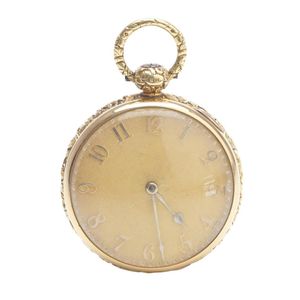Henry Favre's 18ct Gold Pocket Watch with Albert Chain
You must be a subscriber, and be logged in to view price and dealer details.
Subscribe Now to view actual auction price for this item
When you subscribe, you have the option of setting the currency in which to display prices to $Au, $US, $NZ or Stg.
- Embossed / Repousse - Embossing, also known as repousse, is the technique of decorating metal with raised designs, by pressing or beating out the design from the reverse side of the object.It is the opposite of chasing, where the decoration is applied from the front. An embossed or repoussed object may have chasing applied to finish off the design.
- Circa - A Latin term meaning 'about', often used in the antique trade to give an approximate date for the piece, usually considered to be five years on either side of the circa year. Thus, circa 1900 means the piece was made about 1900, probably between 1895 and 1905. The expression is sometimes abbreviated to c.1900.
- Fusee - The fusee movement was used in clocks and pocket watches from the mid 17th century. The fusee is a cone shaped drum within the works that is linked to the barrel of the spring, usually by a length of chain.
As the mainspring loses its tension over time, the cone shaped barrel compensates for this by increasing the tension, by pulling the mainspring tighter, thus ensuring the time remains constant.
Use of the fusee in clocks was superseded by the "going barrel" in the mid 19th century and for pocket watches at the beginning of the 19th century.
The fusee continued to be used in marine chronometers until the 1970s. - Engine Turned - Engine turning is a decorative technique used on metal surfaces to create intricate curving or geometric pattern. The process involves cutting a series of lines into the surface of the metal using a rose engine or decoration lathe which rotates the metal as it cuts, allowing the operator to create a repeating pattern that covers the entire surface. The resulting surface has a shimmering, reflective quality that is often described as "engine turned." Where an engine turned item has been enamelled, the term used to describe the decoration is usually guilloche.
Engine turning was originally developed to decorate metal objects such as firearms, scientific instruments, and other metal objects that required precise and elegant design.
This item has been included into following indexes:
Visually similar items

Robert Roskell Liverpool, an 18ct tri-colour gold openfaced pocketwatch mvt 48568 circa 1850 English fusee Massey lever movement signed Robt. Roskell Liverpool no. 48567 gold engine-turned dial, Roman numerals, outer scroll detail in three-colour gold, Bre

An open face gold pocket watch, key wind movement, circular golden dial with Roman numerals, 18ct gold case, hallmarked London 1834, maker cap, 38 mm diameter

An open face pocket watch by Osborne & Molineaux of Dublin, English fusee cylinder movement, key wind and set, tri-colour 18ct gold ornate dial with raised Roman numerals, 18ct gold case with engraved floral and foliate sides and engine turned lid, diamete

A French quarter repeater fusee verge pocket watch, Curvet and movement and signed Breguet and Files, circular 18ct gold fancy engraved dial with Roman numerals, with engraved hunting scene depicting stag and hound, 18ct gold case, diameter 50 mm, circa 18
